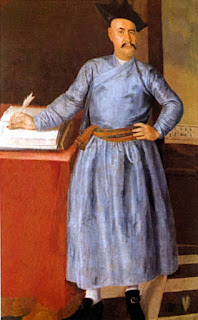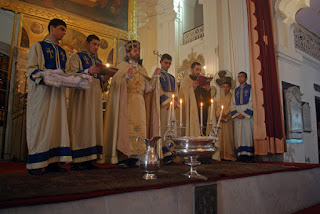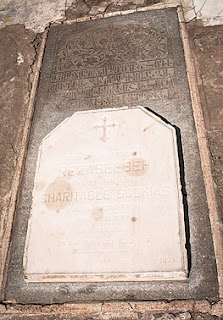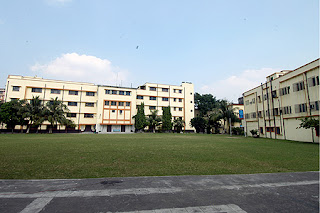Hovhannes Joughayetsi started maintaining a detailed ledger from 19 December 1682. He was from a place called New Julfa, a suburb of Persian capital, Isfahan. In 1605, Shah Abbas, who reinvigorated the Safavid rule in Iran, forcefully shifted his Armenian subjects eastwards. While battling with the Ottomans on the Western front, he was also steadfast in his resolve to promote economic prosperity of his empire. Shah Abbas thus took special care to settle prominent Armenian merchants on the outskirts of his capital Isfahan. This new suburb came to be known as New Julfa (as one of their most prosperous settlements before shifting was a village called Julfa).
Hovhannes that is John in Armenian, was son of a priest, David. When two rich merchants (Khoja Zakar and Embroom, sons of Khoja Guerak) agreed to take him on as a junior partner, it was his chance to make it big in life. With the capital (mostly cash but also some English broadcloth, a total investment of 250 tuman) supplied by his wealthy senior partners, he was expected to travel through India on condition that he should get one-fourth of the profits. This agreement was concluded as per the existing legal traditions of the Armenian merchant community. This legal tradition enjoined upon a partner like Hovhannes to maintain a ledger scrupulously–failure to do so would have invited jail, physical torture, and social ostracism.
Christian Armenian merchants were well known in the Old World for their trading skill, particularly in Chinese silk. Armenian family business firms extended their trading networks from Ottoman ports in the Mediterranean to deep inside China. Though there are evidences to suggest that Armenians were familiar with India trading even in the twelfth century, shifting of their headquarters to New Julfa in 1605 gave a boost to the expansion of Armenian trade network in South Asia. In the backdrop of regular movement of men and material between the Safavid Persia and Mughal India, Armenian traders were invited to Agra by Emperor Akbar. They built the first Church and the first Christian cemetery in Agra in 1562. Abd-al-Hayy, Eskander and his son Zulqarnayn were among the prominent Armenian faces in the Mughal Court. By the mid-seventeenth century, they were visiting major trading centres like Hooghly, Patna, Hyderabad, Masulipatnam, and Lahore.
Armenian traders were invited to Agra by Emperor Akbar. They built the first Church and the first Christian cemetery in Agra in 1562. Abd-al-Hayy, Eskander and his son Zulqarnayn were among the prominent Armenian faces in the Mughal Court. By the mid-seventeenth century, they were visiting major trading centres like Hooghly, Patna, Hyderabad, Masulipatnam, and Lahore.

Hovhannes begins his journey by travelling to Bandar Abbas from Isfahan and then reaches Surat. During the course of next eleven years, he travels to almost all the important cities and towns in North and East India and Deccan including Aurangabad, Burhanpur, Khairpur, Agra, Patna, and Hooghly and then travels up to Tibet, through Kathmandu. He deals in a number of commodities–gold, silver, silk, textile, tea, and musk among others. He operates like an archetypical Armenian trader, who has been described essentially as an arbitrage trader. The ledger, which starts with the signing of a partnership agreement, comes to an end on 6 December 1693 when after a long return trip from Lhasa, he finally reaches Calcutta (how this document found its way to a Portuguese archive that is a mystery, which historians are yet to resolve, though we know that contemporary Armenian businessmen were present in Europe and it is quite tempting to believe that after exploring inner Asia, an adventurous Hovhannes travelled to Europe!).

The Holy Church of Nazareth, located in one corner of Burrabazaar today on Armenian Street, was formally established in 1724, though a temporary structure was perhaps in existence since the 1680s. It was established next to an old Armenian cemetery and the oldest tombstone there is dated 1630, sixty years before Job Charnock officially founded the British city of Calcutta. This tombstone marked the death of a lady named Rezebeebeh Sookia. A small but important street in North Central Calcutta still bears the name of this important Armenian trading family.
The Holy Church of Nazareth, located in one corner of Burrabazaar today on Armenian Street, was formally established in 1724, though a temporary structure was perhaps in existence since the 1680s. It was established next to an old Armenian cemetery and the oldest tombstone there is dated 1630, sixty years before Job Charnock officially founded the British city of Calcutta. This tombstone marked the death of a lady named Rezebeebeh Sookia. A small but important street in North Central Calcutta still bears the name of this important Armenian trading family.

In fact, in the Mughal subah of Bengal, Armenians played an important role in the economic and commercial life of the province. During the 1740s and 1750s, Armenian merchant prince Khwaja Wajid was one of the three most important players in the economy as well as politics of Bengal (along with Jagat Seth and Umichand). Khwaja Wajid held two lucrative monopolies under the Nawabs–monopoly over Salt and Salt Petre. Based out of Hoogly port, he had absolute control over the internal commerce of the province. Till his businesses were ruined and he ended his life in English captivity, he was the most resourceful supplier for all the European companies in Bengal–the English, the French, and the Dutch. In fact, before 1757, both the concessions secured by the British East India Company were negotiated by the Armenians and a grateful East India Company promised to help them in trade everywhere – that’s the reason why Hovhannes came to Calcutta to despatch his stuff to Bandar Abbas through English ships. The East India Company also promised to build and maintain in perpetuity a church in every location with 40 or more Armenians.

Despite their small numbers, they did exceedingly well as businessmen and professionals in colonial Calcutta. From the present Grand Hotel to Stephen Court to Chief Justice’s residence – a number of landmark buildings in Calcutta were actually built by the Armenians. A small community of around 100 Armenians, mostly centred around a small school and college still remain in Calcutta though they are a largely forgotten community in today’s Calcutta.
The other Indian city, which had a close association with the Armenians was Madras. In the first quarter of the sixteenth century, it was a group of Armenian merchants living in Pulikat who guided Portuguese traders to the tomb of St Thomas, the Apostle in the small town of Mylapore. Probably it was the Armenians, who built the old Church there near the tomb. The first Armenian Church in Madras was built in 1712 and this city remained the unofficial headquarters of the Armenians in India for more than two centuries. The first Armenian newspaper Azdarar would also be published from Madras towards the end of the eighteenth century.
Anindya Sengupta is a student of history and co-author of Laxminama: Monks, Merchants, Money and Mantra. He blogs at https://thetimeriver.blogspot.com/